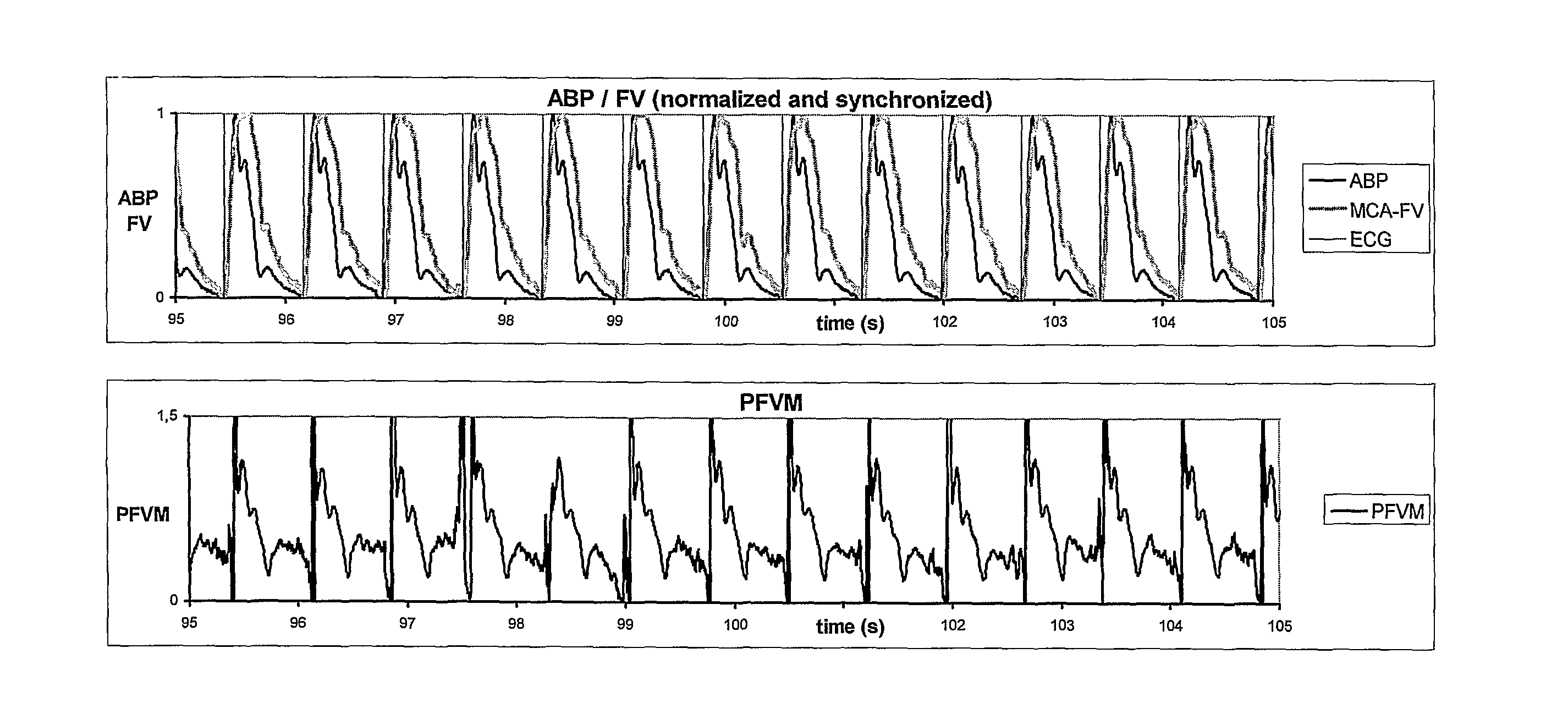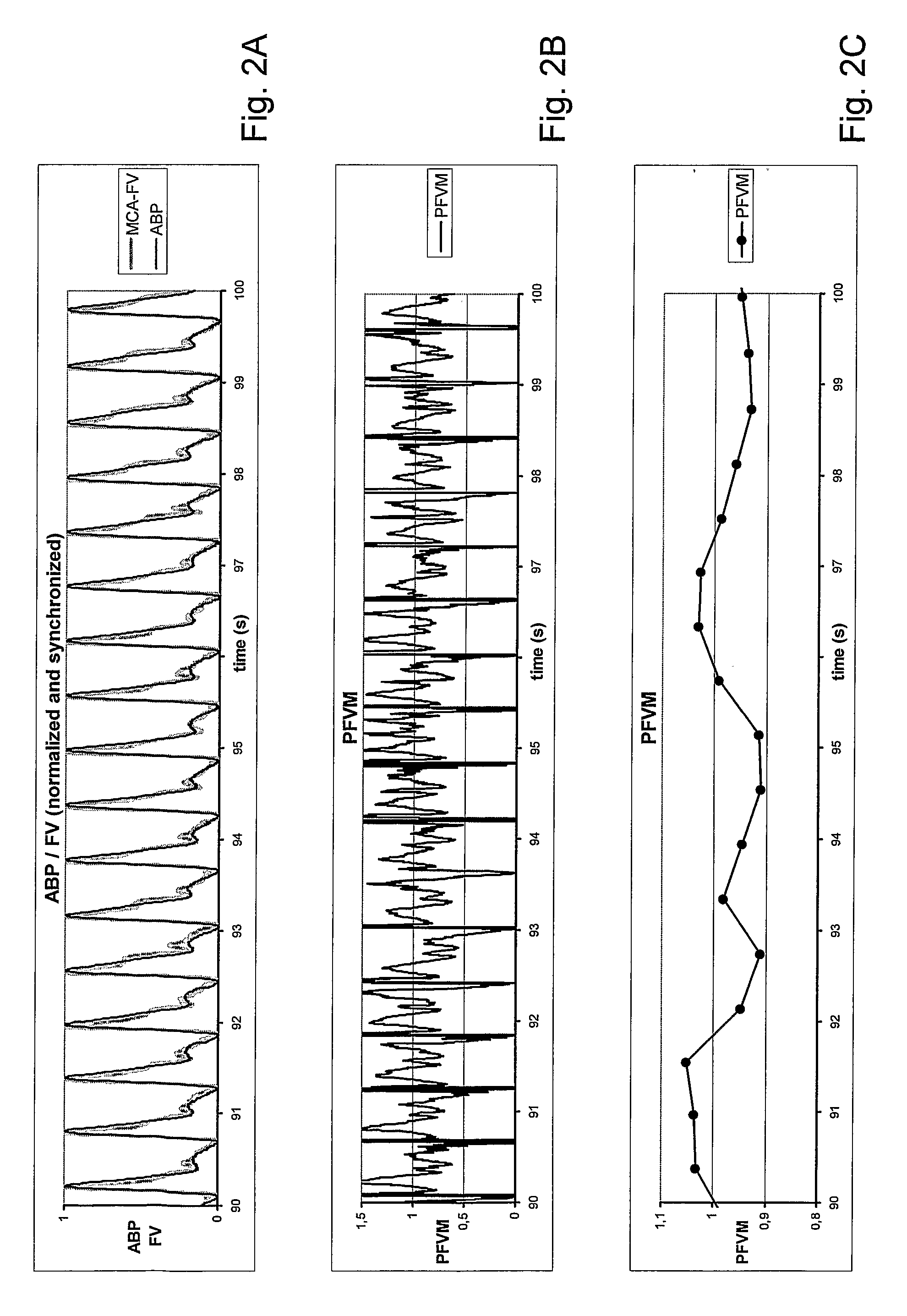System for measuring pulsatile vascular resistance
a pulsatile vascular resistance and system technology, applied in the field of biological signals acquisition and analysis, can solve the problems of relative increase relative decrease in blood flow velocity, increase in vessel diameter, etc., and achieve the effect of dramatic increase in the diagnostic value of tcd monitoring
- Summary
- Abstract
- Description
- Claims
- Application Information
AI Technical Summary
Benefits of technology
Problems solved by technology
Method used
Image
Examples
example 1
PFVM Analysis During During Deep Breathing
[0119]Deep breathing is a well accepted testing procedure for the autonomic nervous system. The large shifts in intrathoracic pressure resulting from the forced breathing activate baroceptors in the heart atria, in the aortic arch and in the carotid bodies. These baroceptors evoke changes in heart frequency synchronous with the respiratory phase. Inspiration (resulting in negative intrathoracic pressures) causes the heart beat frequency to rise whereas forced expiration (resulting in positive intrathoracic pressures) evokes a lowering of heart beat frequency (FIG. 3A).
[0120]The mean normalized pulsatile signals of ABP and MCA-FV may show a biphasic pattern (FIG. 3B). Calculation of the PFVM, however, results in a monophasic oscillating signal in counter-phase with the oscillation of heart beat frequency (FIG. 3C).
[0121]It is noteworthy that the PFVM decreases during forced inspiration and increases during forced expiration. Close analysis of...
example 2
PFVM Analysis During Hyperventilation
[0126]Hyperventilation may result in a significant lowering of the blood level of carbon dioxide. This may have its effect on intracranial as well as on extracranial blood vessels. High levels of carbon dioxide result in vasodilatation, whereas low levels of carbon dioxide induce vasoconstriction. FIG. 5A shows the MCA, BP and heart frequency analysis in a patient performing hyperventilation. During profound hyperventilation the calculated PFVM approaches 1, indicating a marked increase in pulsatile CVR (see FIG. 5B). Since calculation of the PFVM takes into account alterations in systemic ABP, the increase in PFVM can only be attributed to vasoconstriction of intracranial vessels and thus to the action of cerebral autoregulation.
[0127]Forced hyperventilation is a well known treatment for increased intracranial pressure, for instance in severe cerebral contusion. Therapeutic hyperventilation is usually adjusted with respect to the end tidal level...
example 3
PFVM analysis During Cross-Clamping and Clamp-Release
[0128]During cross clamping of the carotid artery for endarterectomy a drop in ipsilateral MCA-FV may occur. Often, the drop in pulsatility of the remaining MCA-FV signal is evident. It was observed that indeed the PFVM over the ipsilateral MCA may decrease somewhat, indicating a slight drop in pulsatile CVR (data not shown). On clamp release, one may expect a marked increase in blood supply to the circle of Willis, since a significant stenosis in the internal artery has now been removed. This increase in blood supply should be counteracted by an increase in cerebrovascular resistance to prevent high pressure levels reaching into the cerebral capillaries. Indeed, on clamp release the PFVM was found to increase dramatically. Tentatively, if the PFVM fails to show such a marked increase on clamp release this may correlate with a higher risk for postoperative hyperperfusion syndrome. This syndrome occurs in roughly 1% of all patients...
PUM
 Login to View More
Login to View More Abstract
Description
Claims
Application Information
 Login to View More
Login to View More - R&D
- Intellectual Property
- Life Sciences
- Materials
- Tech Scout
- Unparalleled Data Quality
- Higher Quality Content
- 60% Fewer Hallucinations
Browse by: Latest US Patents, China's latest patents, Technical Efficacy Thesaurus, Application Domain, Technology Topic, Popular Technical Reports.
© 2025 PatSnap. All rights reserved.Legal|Privacy policy|Modern Slavery Act Transparency Statement|Sitemap|About US| Contact US: help@patsnap.com



